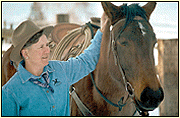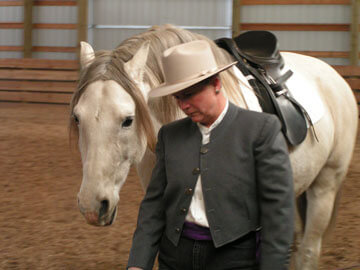Liberty Work: Part 1
by Alice Trindle
The pursuit of developing a true and willing relationship between a horse and their human is thankfully becoming the foundational goal of many. To connect with another living, breathing, thinking being that has four-legs and is so much larger than us, becomes not only a desire that feeds the mind, but also one that touches the soul. The accomplishment of this type of connection, with no strings or lines attached, in what many call “liberty work,” leads to rewards that are beneficial to both horse and human. Plus, it’s fun to boot!
Over the next four months in a series of articles, we will explore the What, Why, and How to of liberty work. We will examine what to look for in recognizing a good effort by the horse and how to give reward. Positioning and timing will be key components to accomplish effortless transitions, figure eights, half-pass, and even show-off spins! The idea is to set the foundation to inspire you to get out there and try some liberty work exercises, whether you are about to hit the trail, ride a dressage pattern, or heading out to gather cattle.
What Exactly is Liberty Work?

I define liberty work as any maneuvers performed with a horse that is accomplished without a physical attachment between the horse and human. This includes no halter and lead, or reins, and no seat. Riding bridle-less does not count as liberty work.
Why Should I Consider Liberty Work?
For many of us, working our horse at liberty may only have been applied in the round pen when we were just starting the horse, and as soon as we were on board, the liberty work disappeared. That is too bad, as the benefits to working with no strings attached goes far beyond colt starting. Here are a few of the attributes that lead me to include liberty work quite often in the lifetime of my relationship with a horse.
- Develops “feel”—from the masters of classical dressage such as Nuno Olivera to true horsemanship mentors like Tom Dorrance, the critical component in becoming a horseman is to develop “feel.” The definition of this term is elusive because it is so much more than the physical or mechanical understanding of riding and goes deeper into emotional, mental, even spiritual connections. For many of us it is hard to imagine developing a feel without something physical connecting us and therefore giving us control. However, with liberty work you let go of that human need to “make” something happen, and move towards a place where you set it up to happen. It sounds rather Zen-ish, but by letting go of the physical strings, you actually learn how to influence the situation by developing a connection, creating a clear picture, and allowing the horse to find the right answer.
- Creates Muscle Memory that will transfer directly to the saddle – Liberty work requires positioning, timing, balance, clarity, consistency, and good posture. All of these elements are attributes that when applied on the ground, will transfer flawlessly to work under saddle. The added benefit is that the horse also becomes habitual about reading your body language, creating muscle memory for him that is familiar when you are in the saddle. Liberty work causes you to utilize a “Horseman’s Protocol” of breathing, picturing, positioning, and allowing, otherwise it will not work!
- It’s fun and rewarding. I recently had the amazing opportunity to see Cavalia, which is a true study in horse-human relationships, and the utilization of liberty work. It was inspirational to see six horses traveling around an imaginary round pen in columns of two, under the imperceptible direction of their human companion on the ground. How fun could it be to have that type of connection and bond with your horse!
As we move forward in this series, I will give you specific exercises to achieve fun liberty work. For now, I recommend looking at some back articles regarding liberty work that can be found at: www.tnthorsemanship.com/articles and checking out the ‘Tip for the Ride’ video on the subject at: http://www.youtube.com/watch?v=gx3N4W9AB_U
See ya next month.
Published May 2012 Issue

Alice was born on a ranch in eastern Oregon, the only daughter in a family of five brothers. She learned to ride behind the back of the saddle holding on to her brother’s belt loops. In the past 15 years Alice has studied with horsemen such as Tom Dorrance, Ray Hun, Dennis Reis, and Bettina Drummon. Her focus is on building a balanced relationship, applying Classical Dressage and Traditional Vaquero principles, via multi-day horsemanship retreats at her ranch in eastern OR.






